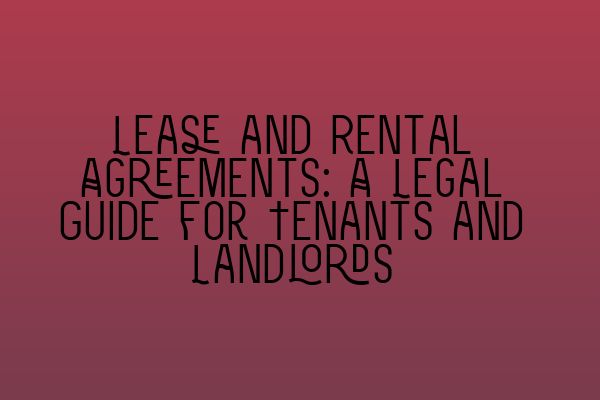Lease and Rental Agreements: A Legal Guide for Tenants and Landlords
Welcome to our comprehensive guide on lease and rental agreements for both tenants and landlords. Whether you are a tenant in search of your dream home or a landlord looking to rent out your property, it is crucial to understand the legal aspects of lease and rental agreements to protect your rights and avoid potential disputes. In this guide, we will cover everything you need to know, from the basics of lease agreements to important considerations and tips for both parties involved.
Understanding Lease Agreements
A lease agreement is a legally binding contract that outlines the terms and conditions of the rental arrangement between a tenant and a landlord. It sets forth the obligations, rights, and responsibilities of each party, providing clarity and preventing misunderstandings.
First and foremost, it is crucial to read the lease agreement thoroughly and understand its contents before signing. The agreement should include details such as:
- The names and addresses of both the tenant and landlord
- The duration of the lease, including the start and end date
- The amount of rent and the due date
- Security deposit information
- Agreed-upon rules and restrictions
Make sure to pay close attention to any clauses related to early termination, maintenance responsibilities, and potential penalties for violating the agreement. Seeking legal advice or consulting a solicitor can be beneficial to ensure you fully understand the terms and conditions.
Common Types of Rental Agreements
There are several types of rental agreements, each with its own features and implications. The most common ones include:
- Fixed-term lease: This type of lease has a specific duration agreed upon by the tenant and landlord. It provides stability and security for both parties.
- Month-to-month lease: As the name suggests, this lease agreement continues on a month-to-month basis until either party provides proper notice for termination.
- Joint tenancy: In a joint tenancy, multiple tenants are jointly and severally liable for the rent and other obligations. This means that they are all equally responsible for the full rent amount and any damages.
- Sublease: A sublease occurs when a tenant rents out all or part of the property to another person, known as the subtenant. The original tenant remains responsible for the lease obligations.
Understanding the type of rental agreement you are entering into is crucial, as it can have significant implications for your rights and responsibilities.
Tips for Tenants
Tenants should keep the following tips in mind when entering into a lease agreement:
- Read the lease agreement thoroughly before signing and seek legal advice, if necessary.
- Inspect the property carefully and document any existing damages or issues before moving in. This can help protect you from being held responsible for pre-existing problems.
- Communicate any maintenance or repair requests promptly to your landlord in writing, and keep copies of all correspondence.
- Pay rent on time and adhere to the agreed-upon rules and restrictions in the lease agreement.
- Give proper notice if you wish to terminate the lease agreement.
Taking these steps can help you maintain a positive relationship with your landlord and ensure a smooth rental experience.
Tips for Landlords
Landlords should take note of the following tips to ensure a successful rental experience:
- Create a comprehensive lease agreement that clearly outlines the rights and responsibilities of both parties.
- Conduct a thorough background check on potential tenants to ensure they are trustworthy and reliable.
- Maintain the property and address any repairs or maintenance issues promptly to provide a safe and habitable environment for your tenants.
- Keep accurate records of all communications and transactions related to the rental property.
- Understand and comply with all relevant landlord and tenant laws and regulations in your jurisdiction.
Following these guidelines can help you establish a positive reputation as a landlord and protect your interests in the rental property.
